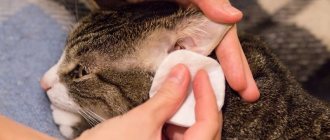Undoubtedly, pets are full members of the family. They bring us joy, we take care of them, feed them and play with our furry friends. But it happens that our furry friend becomes lethargic and sad. Of course, we worry about what could have happened. Next we will talk about one of the ailments - ear problems in cats. Let's look at this issue in more detail.
Reasons why a cat may scratch its ears
The causes of itching of the hearing organs can be various. The main ones:
- water getting into your pet's ear canal;
- getting any foreign object into the ear;
- the presence of ear mites in a cat;
- development of otitis media;
- bruise and subsequent occurrence of ear concha hematoma;
- fleas that irritate and bite the cat;
- skin diseases of fungal origin;
- infectious ear diseases;
- improper hygiene of the cat’s ears and ear canals.
A cat scratches its ears: what to do to understand whether it’s time to see a doctor or not
If a cat scratches its ears constantly, then it is necessary to observe and conduct an external examination of the animal to identify the first signs of disease:
- the ears are hot, red or intensely pink;
- discharge of fluid or pus is visible inside the ear;
- there are scratches, scratch marks, bloody or yellow crusts on the surface;
- there was an unpleasant smell from the ears;
- instead of an even layer of hair near the auricle, bald spots appeared;
- the cat makes unnatural movements, as if trying to shake something out of its ear;
- the animal does not allow itself to be stroked on the head and the ear canal examined;
- the cat tries to scratch its ear on any objects;
- appetite has worsened;
- the cat sleeps or lies all the time, activity is lost.
Diagnosis and treatment of ears
The owner can identify some diseases himself. For example, ear mites can be easily identified if you carefully move a cotton swab in your pet’s ear, and then wipe it on a black cloth and look through a magnifying glass. But the problem is that diseases can occur in combination. Ear mites are very popular, and it is likely that the pet has several other ailments that a self-confident owner may miss.
In a clinical setting, the cat is examined more thoroughly. The doctor may perform the following tests on your pet:
- bacterial sowing;
- x-ray;
- Ultrasound;
- smear.
The test results will determine the entire treatment regimen. If a cat has otitis media, you cannot do without antibacterial drugs. Novocaine and special ear drops may be needed. The tick is expelled with such means as “ Tactic ” and “ Amit ”; intramuscular antiparasitic injections perfectly treat the disease. The ears are regularly cleaned with hydrogen peroxide. The veterinarian monitors the pet throughout the entire treatment period.
Be attentive to your mustachioed pet, and then he will only need to scratch his ears for pleasure.
When to see a doctor
For any cat, scratching its ears is a normal process, which is a hygienic procedure that helps the animal get rid of dirt and foreign bodies. But when it becomes permanent, and the pet experiences great discomfort and anxiety, it is necessary to show it to a doctor. Only by identifying the reasons for this behavior can effective treatment methods be selected.
If a cat has otitis media, measures taken to get rid of ear mites can lead to serious consequences, including complete hearing loss. A visit to the clinic should not be postponed if:
- Ear scratching causes anxiety, causing the cat to shake its head in irritation.
- The animal becomes nervous.
- The cat scratches its ears vigorously more than 10 times a day.
- Small wounds appeared on the surface of the ears.
Detection of one or more of the listed symptoms is a serious reason to visit a doctor.
Why is there a problem?
Yeast propagation
If a cat shakes its head and scratches its ears, then the source of the disorder may be the activity of pathogenic microorganisms, such as yeast. Veterinarians warn that the disease poses a danger to the health of the animal and if treatment is not carried out in a timely manner, the pet’s hearing function will greatly deteriorate, up to complete hearing loss. The progression of a fungal disease can be noticed by the fact that the cat constantly scratches one or both ears and often shakes its head. The disease is characterized not only by itching, but also by an unpleasant odor from the ear, caused by an abundant accumulation of dark wax.
Reasons for the development of otitis media
If owners find that the cat is shaking its ears and there is discharge around them, this may indicate an inflammatory reaction. If there is a violation, the internal, middle part of the organ becomes inflamed, or the pathological process occurs externally. The development of otitis media, which causes itching in the ear, is influenced by the following factors:
The disease can affect the hearing organs if the animal is hypothermic.
- scabies that was not cured in time;
- earwax plug;
- hypothermia of the cat's body;
- foreign object entering the ear;
- infections;
- impaired functioning of the pancreas or liver.
With otitis, owners observe that the cat has scratched the skin in the ears, but other symptoms are also characteristic of the disease:
- itchy sensations;
- uncontrolled head movements;
- problems with appetite;
- secretion of pathological fluid;
- brown crusts inside the ear.
How do ear mites appear?
When a kitten scratches its ears or often covers a diseased organ with its paw, this may signal the activity of such parasites. Owners observe that the pet's head often twitches. In veterinary medicine, this disease is also called scabies. The progression of pathology is influenced by a weak immune system, as well as individuals living in large groups at risk of infection with ear mites. When the course is advanced, the cat scratches its neck and an unpleasant-smelling discharge from the ears is detected. The disease can be recognized by a number of clinical signs:
- itchy sensations in the ears;
- brown coating;
- discomfort and restless behavior.
If ear mites are not diagnosed in a timely manner, the cat is likely to rupture the membrane and develop meningitis. Complications are possible even if the pathology occurs in one ear, but both organs are treated at once.
Ulcers: what are they?
When a cat scratches its ears, this can also signal the progression of an abscess. An abscess can appear even in a pet whose ears are clean. Owners are strictly prohibited from squeezing out purulent formations. Scratches and mild injuries can influence the development of the problem that causes the cat's ear to itch. If you try to get rid of the abscess on your own, there is a high probability of blood poisoning and the death of your pet.
Dermatitis or eczema
If an animal is prone to allergies, then this pathology may appear in it.
If a cat shakes its head and has red ears, this may indicate a dermatological disease. The pathology can manifest itself against the background of an allergic reaction, and the disorder can also be of a bacterial or fungal nature. If diagnosed early, dermatitis and eczema do not pose a threat to the cat’s health and can be treated with medication. The pathology is most often recorded in pets with flattened ears, but the dermatological disease also occurs in other breeds of the cat family. It is possible to recognize a disease in the ear area by the following clinical picture:
- rashes inside and outside the ear;
- inflammatory reaction;
- redness of the skin;
- swelling and blistering;
- the appearance of scales and cracks;
- hyperthermia;
- severe itching and burning sensation.
Features of hematoma
If the concha of the animal’s auditory organ looks swollen, then such a pathology should be suspected.
If a cat scratches its ears, then you should take a closer look to see if its blood vessels are damaged. A domestic cat rarely suffers from a hematoma; pets that are often outdoors and in contact with other felines are at risk. Owners may notice that the cat has red or bluish skin behind the ears. It is not uncommon for a cat to have drooping ears after mechanical damage. Hematoma can be recognized by other signs:
- swelling of the ear;
- increase in temperature at the site of damage;
- formation inside the ear that has clear boundaries;
- constant shaking of the head;
- anxiety.
How to cure ear mites using BlochNet max drops
To treat ear scabies in a pet, the drug is instilled into each ear, 4-6 drops. To distribute the drug evenly, the auricle is massaged. The ears are treated two to three times with an interval of 5-7 days.
- The use of BlochNet max drops guarantees high efficiency in the treatment and prevention of infection of cats with ear scabies.
- BlochNet max is safe. Does not have an allergenic or irritating effect.
- The droplet shape is convenient for treating cats against ear mites. BlochNet max is available in bottles with a screw cap, which allows you to store the bottle after opening for the entire stated shelf life.
Features of treatment depending on diagnostic results
It is important to remember that the specific treatment will depend on the diagnosis given to the animal. Therefore, you should not neglect a thorough examination of your pet and its examination at a veterinary clinic.
Treatment of otodectosis
If your pet is sick with otodectosis, then you should begin treatment immediately, since as the disease progresses, it can lead to membrane rupture, meningitis and inflammation. It is important to note that it is necessary to treat both ears at once. To avoid re-infection, the animal’s bedding and toys are either treated or replaced with new ones. First, the pet's ears are cleaned of pus and other existing contaminants. After this, you should choose a medicine for treatment, there are:
- ear drops (use once a week);
- drops on the withers (use once every three weeks).
The appropriate option will depend on the degree of development of the disease and the condition of the cat. The average course of treatment is one and a half months. To pour the medicine into the ears, use pipettes and syringes without needles. To enhance the effect, massage the auricle with your fingers. Light pressure will help distribute the medicine evenly, which will allow you to quickly get rid of ticks and their larvae.
The effect of medicinal drops is quite irritating, so the cat may react to the administration of the drug quite aggressively, which is the norm.
Help with abscess
An abscess should be opened by a veterinarian. The specialist will not only treat the resulting hole with antimicrobial agents, but also, if necessary, install drainage. The latter is necessary in order to prevent the re-accumulation of pus and completely heal the wound. In some cases, the animal is additionally prescribed antibiotics to help fight inflammation.
Removing wax plugs
Sulfur plugs are removed by pre-soaking them. For these purposes, saline solution and hydrogen peroxide are used. But a much more effective option are special lotions that can be purchased at a veterinary pharmacy. They allow you to gradually soften the resulting plug. There is a high probability that after several procedures the cat will independently free itself from the formation that is interfering with it during the next shaking of its head. Do not use cotton swabs to remove the wax plug, as this will push it further and harm the animal.
Treatment of otitis media
In case of otitis, treating the ears with a special solution also plays an important role. There are antiseptic and drying lotions, as well as agents that dissolve sulfur. The appropriate option will depend on the type of otitis media. In this case, the selected solution is poured into the affected ear and the shell is massaged. In the initial stages of otitis, treatment is carried out up to twice a week. For severe illnesses, the solution is used up to four times.
Table: common medications for the treatment of ear diseases in cats
| Name | Indications for use | Packaging | Approximate cost |
| Amit |
| 20 ml | 165 rub. |
| Bars ear drops | Otodectosis | 20 ml | 180 rub. |
| Bars lotion |
| 20 ml | 130 rub. |
| Dekta | For the treatment of ear scabies complicated by otitis media | 6 ml | 110 rub. |
| Ectodes | Prevention and treatment of ear scabies (otodectosis) | 10 ml | 55 rub. |
| Otoferonol | Prevention and treatment of otitis not of tick-borne etiology | 5 ml | 85 rub. |
| Otoferonol Plus | Anti-mite, anti-inflammatory, disinfectant | 5 ml | 90 rub. |
| Otodepin |
| 10 ml | 45 rub. |
| Serco ear drops |
| 5 ml | 53 rub. |
| Otokan | Treatment of tick-borne otitis complicated by bacterial and fungal infection | 10 ml | 48 rub. |
Photo gallery: veterinary products for the treatment of ear pathologies
Amit is an antiparasitic agent, it is used to destroy demodectic and sarcoptic mites Bars - ear drops that have acaricidal, as well as mild anti-inflammatory and antimicrobial effects Bars ear cleaning lotion facilitates the removal of earwax, dirt and inflammatory exudate from the auricle and ear canal of dogs and cats Dekta - a complex acaricidal drug for external use Otodepin - ear drops intended for regular hygienic treatment of the ears of pets Otoferonol - an anti-inflammatory and antimicrobial drug intended for the treatment of otodectosis in cats and dogs
Hematoma of the auricle
A hematoma is an accumulation of blood under the skin of the ear. More often it occurs on the inside of the ear. Causes of hematoma: trauma, bites, scratches. The cat becomes restless, the ear swells, and pain appears. Small hematomas resolve on their own after a few days. For extensive hematomas, you will need the help of a veterinarian. The specialist makes a puncture or incision to empty the contents of the hematoma. The opening area is treated with antiseptics and antibiotics.
How to treat if a cat scratches his ear until it bleeds
If the cat scratches the ear until it bleeds, then the wound is treated with hydrogen peroxide and sprinkled with crushed Streptocide tablets or lubricated with Panthenol, Trauma-gel or Ranosan ointment. It is not recommended to use iodine, brilliant green and Vishnevsky liniment on the auricle. These products have a strong cauterizing effect and can cause burns.
How to examine a cat's ears?
It would seem that this task is not at all difficult. However, some cats are quite shy, and for others this procedure is extremely unpleasant, so they may behave restlessly and cause discomfort during examination .
- Take the animal in your arms. Let it lie down for a while and calm down. You can also stroke the cat in the direction of hair growth, scratch the neck or behind the ear.
- Gently and smoothly move away the auricle to better examine its condition. It is advisable not to use bright light, because the pet may get scared and run away.
Cleaning your ears correctly
The kitten's ears should be examined periodically, once a week is recommended. This procedure will avoid itching from contamination. As soon as the owner begins to notice that the kitten often scratches its ears, and that there is a coating of dust, excess wax, and dried crusts in the auricle, it is necessary to immediately clean the ear.
shutterstock
For this procedure you will need:
- special ear cleaning products (lotion, gel), can be replaced with water or oil;
- several cotton pads;
- cotton buds;
- dense fabric if the kitten scratches and does not sit quietly.
Cleaning the kitten's ear is carried out calmly without sudden movements, moving from the inside out. All products are applied to a cotton pad or cotton swab. It is forbidden to drop anything inside the ear.
Ear abscess
An abscess on a cat's ear appears as a result of trauma, injury, cut or scratch. Externally, an abscess looks like a hematoma, with only one difference - the abscess is filled with pus, not blood.
Symptoms:
- inflamed area of inflammation that is hot and soft to the touch;
- discharge and unpleasant odor from the ear;
- there may be a scab or puncture wound in the area of the tumor;
- Your cat may show symptoms of a fever, including lethargy and lack of appetite.
Treatment of ear abscess
If you notice an abscess in your cat's ear, contact your veterinarian immediately. At the first stage of the disease, he will prescribe a penicillin-novocaine blockade in combination with warm compresses from sulfonamide drugs.
At the second stage of the abscess, the veterinarian will open the inflammation and remove the pus. Then he will treat the wound with antiseptic drugs and prescribe a course of penicillin or cephalosporin antibiotics.
Diagnosis of ear diseases in cats
At the first sign of itching in the cat’s ear area, you should watch it, and, if possible, sit the pet on your lap and turn out the ear. Consider whether there is redness, dark plaque, foreign objects or inflammatory nodules.
Palpate the parotid area for swelling and tenderness. If you identify suspicious processes, you should immediately seek help from a specialist.
In a clinical setting, ear problems in cats are determined in the following ways:
- During an examination by a veterinarian, the ear canal is examined with an otoscope (the device allows you to see neoplasms, hematomas, foreign bodies, genetic abnormalities, and inflammatory processes).
- Scraping of ear secretions for microscopy and determination of the nature of the pathology (fungus, ear mites are determined).
- Biopsy of tumors in a cat’s ear to determine malignancy.
An experienced doctor can often visually determine the cause of the disease and prescribe treatment for the cat without laboratory tests.
The cat scratches its ear and shakes its head: reasons
When a cat scratches its ear and shakes its head, it is important to know what to do to help your pet.
There are many reasons for the appearance of such symptoms. Veterinarians identify several diseases as the main ones. They are especially common in cats and can appear in an animal at any age.
Pets that have free access to the outdoors suffer the most from ear infections. Also, strange behavior can be caused by tumors in the ear cavity, allergies (especially if the allergen penetrates directly into the ear) and skin diseases.
A disease in an animal can be suspected if head shaking and scratching are more than one-time in nature and are accompanied by the following manifestations:
- the appearance of irritability;
- frequent shaking of the head, after which the cat keeps its head tilted to the side for some time;
- scratching in the ear area;
- redness and swelling of the ear;
- aggressive behavior of the pet in response to attempts to touch his head.
This symptomatology is typical for most ear diseases.
Ear scabies, ear mites (otodectosis)
Otodectosis is one of the most common ear diseases in cats , which quickly spreads from animal to animal, causing itching and inflammation in the ears.
The kitten may even die from the disease.
Infection most often occurs due to contact of a domestic cat with street relatives, who, as a rule, are carriers of the disease. Infection from dogs occurs in exceptional cases, since they are practically not susceptible to pathology.
The mite parasitizes directly in the ear or on the skin next to it. The second option is noted less frequently. An accumulation of liquidish brown secretion appears in the ear, which dries and forms dense crusts.
Be sure to read:
Why does a cat bite and gnaw its tail strongly, sometimes until it bleeds? Should I be worried?
As a result, the ear becomes dirty.
In a veterinary hospital, scraping determines the presence of adult parasites, its larvae and eggs. Treatment is carried out using drops or injections.
The first method is easier for the cat and is used in most cases. Injections against otodectosis are given to young animals with severe infection.
Notoedrosis
The disease is also caused by ticks . The parasites that cause this pathology are sarcoptoid mites, which settle in the skin not only in the ear area, but also throughout the body, causing itching.
The insect initially appears on the cat's head and, if left untreated, gradually spreads throughout the body. The skin in areas where mites are present becomes dry, a dense crust forms on it, which gradually cracks, leading to the formation of painful wounds. They often become infected, which aggravates the animal's condition.
Ear scabies, ear mites (otodectosis)
To determine the disease, a scraping with further examination is required. It is not possible to cure the pathology on your own, so a mandatory visit to a veterinarian is required. In advanced forms of the disease, therapy is complex and lengthy.
Important! If you suspect that your cat has a tick-borne infection, you should definitely contact a specialist. Treatment of the disease at an early stage will cost much less.
Fleas
This most common skin parasite in pets leaves bites that cause severe itching. Flea allergies in cats cause skin inflammation. Insects cause concern not only for cats, but also for their owners, as they bite all warm-blooded animals. It is necessary to remove the parasite as quickly as possible from the moment it appears in the animal.
Fleas, being in the ears of a cat, are almost inaccessible to her, and therefore they cause special concern there. The animal may scratch the area behind the ear vigorously until ulcers form.
Treatment of the problem comes down to removing parasites. For this purpose, drops on the withers or sprays are used. In severe cases, when it is not possible to remove fleas using conventional means, an antiparasitic injection is used.
Otitis (ear inflammation)
Otitis media, or inflammation of the inner ear, is a common condition in cats that can cause serious problems ranging from deafness to inflammation of the brain.
Be sure to read:
A cat has a lump under the skin on its stomach: what is it, causes and treatment, what to do if it festers
The cause of its appearance is fungal and bacterial diseases, severe hypothermia, allergies, a number of pathologies of internal organs, as well as the presence of a foreign object or insect in the ear.
Otitis media, or inflammation of the inner ear
For proper therapy, it is necessary to accurately determine what factors caused the development of the disease. To do this, a history is taken, a swab is taken from the ear, and in some cases a blood test is prescribed. If there is discharge of pus, this indicates a bacterial form of the disease.
Treatment depends on what caused the inflammation. In most cases, the use of general or local antibiotics is required. The affected ear is also usually washed to remove excess secretion.
Hematoma
Hematoma refers to the consequences of injury. Usually one side suffers. A hematoma is formed due to a blow to the ear, when blood from a damaged vessel, while maintaining the integrity of the skin, pours into the interstitial space.
Hemorrhage causes an unpleasant feeling of pressure in the damaged area, causing the cat to shake its head. Treatment is carried out only by a veterinarian. Often a blockade is enough, which will eliminate the discomfort until the hematoma resolves on its own. In more severe cases, surgery may be required to open the hemorrhage.
Sulfur plug
Ear cleaning can be done at a veterinary clinic or at home.
The problem only arises if the plug becomes very large. The animal does not experience pain, but loses hearing, which causes concern. It is enough to remove the plug for the cat’s condition to return to normal.
Ear cleaning can be done at a veterinary clinic or at home. At home, sulfur is softened with saline solution, and the cat shakes it out itself. The treatment process takes several days.
What to do?
If you notice that your pet is experiencing severe ear itching, in order to help your pet, it is very important to determine the root cause that caused this problem. To do this, you should go to the veterinary clinic and show the cat to a veterinarian
Treatment methods and duration of treatment will depend on the form, stage of the disease, root cause, age, and general condition of the animals. Cats can be prescribed general and local medications.
In some cases, to normalize the general physiological condition of animals, veterinarians prescribe a therapeutic diet, immunomodulators, and maintenance drips.
When diagnosing chronic diseases of the ears, purulent forms of otitis media, and otodectosis, surgical intervention may be required.
If your cat scratches its ears, experiences discomfort, pain, crusts, scabs, ulcers, or dark brown plaque are visible in the ears, you should not delay a visit to the veterinary hospital. The faster the diagnosis is made, the greater the chances of a favorable outcome.
conclusions
When starting to help your pet, you should clearly know what it is sick with. The best help will depend on making an accurate diagnosis.
Help will depend on an accurate diagnosis.
You definitely need to take a close look at the animal and find out all the warning signs accompanying the main symptom.
The doctor will need this information to determine the full clinical picture. Under no circumstances should you try to help an animal yourself if you are not sure of the exact diagnosis.
Causes of head tremors
A healthy cat can move its head from side to side before jumping. At the same time, he can bend down to the ground and twist his croup, or he may not do this. Carefully and concentratedly following the object of interest with its eyes, the cat can make twitching movements of its head from side to side with a small amplitude.
During sexual arousal, animals may experience slight tremors. The cat can make small movements with its head. The trembling usually spreads throughout the entire body.
The causes may also be pathological. In this case, the tremor is caused by a disease, and the cat must be treated.
Head tremor, as a symptom, develops in the following diseases:
If an animal scratches its ears furiously and shakes its head, it most likely develops a parasitic disease - ear scabies (otodectosis). The disease is caused by a small tick that literally bites into the delicate tissue lining the animal's ear. This is accompanied by severe itching, and the cat literally tears its ears and shakes its head, trying to get rid of the discomfort. A cat may meow pitifully when scratching its ear. Upon visual inspection, the owner may notice abrasions and scratches on the auricle and brown-black discharge in the cat’s ear canal. They consist of dried blood and tick waste products. Simply cleaning your ears will not solve the problem. A cat may shake its head if it has a wax plug in its ear. This condition causes discomfort in the animal and decreased hearing. A foreign body stuck in the ear canal can also cause tremors. Pieces of dirt and small pebbles can get into the ear, especially if the cat has been rolling on the ground outside. Water getting into the ear. If the owner notices that the pet is shaking its head after bathing, there may be water in the ear. Cats often shake out water on their own and no special assistance is required. By the way, symptoms may not appear immediately, but 4-6 days after water procedures. Ear injuries. They most often occur after street animal fights. The wound can fester and cause severe discomfort and pain. The animal shakes its head, thus trying to get rid of unpleasant sensations. Infestation with parasites, such as fleas. If fleas are not removed, they quickly multiply on the cat’s body. Their number is growing by leaps and bounds. Fleas are small in size and can easily get into a cat's ears. It is very easy to understand that there are fleas in the ears: the cat scratches not only the ears, but also the entire body. Infection of the ears with fungi and bacteria, which cause severe itching in the auricle. Dermatitis, which can occur on any part of the animal’s body, including the ears. In this case, the cat not only shakes its head, but also actively itches, and weeping ulcers form on the surface of the ears.
Otitis media can cause your pet to shake its head. In this case, the cat does not allow the ear to be examined due to pain, and may even bite the owner. The ear may not smell very good (a purulent odor appears) and purulent contents may leak. Some neurological diseases cause involuntary head tremors. A cat may shake its head with encephalitis, developing stroke, dizziness, head injury and other pathologies
In this case, you need to pay attention to additional symptoms: unsteadiness of gait, pupils of different sizes, movements in a circle. New growths in the ear that block the ear canal and disturb the cat. Most often, the well-known papillomas occur, but all kinds of cysts, as well as malignant tumors, also occur. Head twitching develops in an animal with liver, kidney or multiple organ failure
They indicate the failure of one or another organ. This is a serious condition for the animal, which can result in its death. Such twitching does not occur against the background of good health of the animal. The disease proceeds with its characteristic symptoms, and already at the last stage tremor develops.
Possible reasons
It is normal for a pet to occasionally scratch its ears. A healthy kitten scratches its ear up to 4 times a day. The only cause for concern should be frequent scratching. This could be a sign of a dangerous disease.
© shutterstock
The most common reasons for a kitten constantly scratching its ears:
- Ear scabies . The cause is a tick that parasitizes animals. Penetrates into the ear, where it settles and causes discomfort. The kitten shakes its head and scratches its ear vigorously. The affected area turns red and swelling appears. Antiparasitic drops are used for treatment.
- Notoedrosis is a very dangerous disease. The causative agent is the sarcopid mite. In addition to the ear, it affects the eyes and nose. The affected areas are itchy, and the kitten constantly scratches them. The skin dries out and bursts. Treat with antimicrobial ointments, antibiotics and antiparasitic drugs.
- Otitis - can occur from hypothermia in a kitten. The inner or middle ear is inflamed and there is discharge. The kitten may shake its head or tilt it to the side of the affected ear. Treatment with antibacterial therapy is prescribed by the doctor.
- Foreign body in the auricle . If you notice it, try to pull it out yourself. If your attempt is unsuccessful, contact a specialist.
- Ear injuries . For minor wounds, treatment with an antiseptic is indicated.
- Sulfur pollution.
The owner of the animal needs to examine his ward and try to figure out the problem. If the symptoms are caused by a buildup of earwax, this can be easily corrected by performing ear hygiene. In all other cases, it is recommended to contact a veterinary clinic.
Ear infection
Why does a cat shake his head from side to side and scratch his ears? It is possible that he has inflammation of the inner, outer or middle ear. This disease may appear due to untreated or severe scabies. Other causes of inflammation:
- sulfur plug;
- hypothermia;
- foreign object in the ear.
Sometimes this disease is provoked by infections. If there is pancreatic or liver dysfunction, the cat may also scratch its ears. Brown pellets are also observed in the shells.
Symptoms of the disease:
- Itching in the ears.
- Uncontrolled head movements.
- Decreased appetite.
- Fluid in the ears.
Causes of itchy ears in cats
There can be several reasons for itchy ears in cats. If a kitten scratches its ears, then the first step is to inspect the auricle. The choice of the necessary treatment depends on this. Please note that it is better to entrust the selection of medications to a veterinarian.
1. The most common ear problem in kittens is ear mites or, scientifically, otodectosis. Otodectosis is a parasitic disease. It is important to know that in advanced forms of the disease, cats may experience hearing loss as the ear mites spread deep into the ear. Ear mites cause significant discomfort to the animal, because the parasite bites through the skin in order to saturate it with blood and lymph. Because of this, blood appears in the pet's ear. Recognizing an infestation is quite simple. When examining the ear, a dark brown coating similar to crusts will be visible.
Symptoms of ear problems
You can notice any discomfort by looking closely at the animal’s behavior.
The following symptoms may indicate ear problems in a kitten:
· the kitten may shake its ears;
· purse your ears;
· comb the inner surface of the ear;
· when examining the auricle, redness, dirt, and sores are noticeable;
Ear problems may be accompanied by a strong odor;
· the cat does not allow you to touch its ears;
Possible manifestation of aggression.
You need to understand that periodic ear scratching without any accompanying symptoms is not necessarily a disease. The kitten is cleaning its ears, what should I do? If a kitten scratches its ears, then perhaps it simply cleanses them of dirt; this process is inherent in nature. In this case, nothing should be done. But if, for example, scratching is noticeable behind the ear, then it is better to consult a veterinarian. So, you noticed that the kitten is scratching its ears, let's look at the reasons.
The cat's ears itch inside: what to do at home
If your cat's ears itch, but there are no signs of inflammation (redness, irritation) or scratching, then you can clean the earwax from the ears at home. To do this, use a sterile saline solution (0.9% sodium chloride), a pipette and cotton swabs with special limiters.
Every day for 7 days in a row, 2 drops of saline solution are dripped into each ear 3 times a day. It should have a temperature of 38 degrees; to warm it up, the pipette is lowered into warm water. Within a week, the plug usually softens, falls out and comes out. You can remove the remaining earwax with cotton swabs.
You should not wash your cat's ears with hydrogen peroxide, soap or alcohol solution. It is forbidden to use thermal procedures, since in the presence of a purulent infection this will lead to its spread to the membranes of the brain.
The main types of ear diseases that cause itching
Any disease of the cat's hearing organ in the first stages can only cause itching. That is why it is so important to show the purr to the doctor in time. A timely visit to the doctor will allow you to identify the disease at an early stage, start treatment on time and avoid quite serious complications.
- One of the main causes of intolerable itching in a cat is scabies, which is caused by an ear mite - otodecosis. With this disease, a microscopic but extremely harmful skin-eating, blood-sucking parasitic mite settles in the cat’s ear. It really bothers the cat, causing itching and inflammation in its ear. A cat's ear can itch unbearably, and the animal begins to scratch it until it bleeds.
- Otitis is an inflammatory process in a cat’s ear; in the first stages of the disease it causes itching, then pain appears. Visually, it seems that the pet has dirty ears with plaque. This disease can be of bacterial, parasitic or mixed origin.
- Allergies in cats can cause quite intense itching sensations. It occurs against the background of the cat’s body’s rejection of certain products, a reaction to household chemicals, even special cat hygiene products, as well as to house dust or pollen from plants that bloom in season.
- Skin diseases in cats, leading to itching in the pet’s ears as well.
- Neoplasms in the ears of an animal are quite rare, but they can also cause unpleasant sensations, making your pet want to scratch its ears.
If a cat scratches its ears until it bleeds, shakes its head: the main reasons
If a cat scratches its ears until it bleeds and shakes its head, then the cause is:
- accumulation of blood due to injury - hematoma;
- inflammation of the outer, middle and inner ear - otitis media;
- infestation with fleas and ticks (otodecosis);
- allergic reaction to food, drugs, pollen;
- fungal infection (lichen);
- impaired sebum secretion - seborrhea;
- entry of a foreign body.
Hematoma (bruise)
When a head injury occurs, a fight with relatives, or compression of the ear, an accumulation of blood occurs - a hematoma. Its appearance is explained by slight injury to the delicate and thin skin of the ears, which have an active blood supply. Therefore, even a small impact is enough to damage blood vessels.
If the surface layer is not damaged, then the blood permeates the tissues, then the cat’s ear hurts and itches, and the damaged area swells and a bluish or purple color appears (bruise). The auricle changes shape, thickens, may sag or even be pressed against the head.
With a hematoma near the ear, the skin becomes hot, and a soft formation of varying sizes can be detected. The cat does not allow us to examine and palpate the ear because of the pain. A characteristic sign is tilting the head towards the affected area and general anxiety. Possible refusal of food and decreased physical activity.
Otitis of various etiologies
When a cat's ears are dirty and itchy, the cause is inflammation - otitis media. It occurs when infected with a bacterial, viral or fungal infection. Allergic and parasitic otitis media may also occur in cats. The provoking factor is hypothermia, water getting into the ear, weakening of the body due to concomitant illness, and fasting.
The development of the disease can be acute. Then the animal:
- local and general temperature increases;
- loss of appetite;
- any touch to the ears causes severe anxiety;
- there is brown or green discharge from the ear canal in the form of crumbs or a liquid, lumpy mass;
- redness of the ears occurs;
- activity is absent or reduced.
With otitis media, the cat meows and dodges stroking, and the itching is so unbearable that he scratches his ears until they bleed. Wounds can also fester, worsening the animal's condition.
If acute inflammation is not detected in time and the full course of treatment is not carried out, then otitis media becomes chronic. Periods of exacerbation alternate with subsiding of symptoms. Advanced disease leads to deafness, paralysis of the facial nerve, and infection in the brain. Extremely severe otitis media causes death.
According to the location of the lesion, otitis media can be external (inflammation of the external auditory canal, part of the auricle), middle (eardrum area) and internal (vestibular apparatus responsible for balance).
Flea infestation
If a cat twitches its ears and constantly scratches them with its paw, becomes restless and loses weight, then this may be due to flea infestation. These parasites can be found in both street and domestic animals. Infection occurs through contact with another cat, or the owner may bring fleas on shoes or clothes. Irritation of the skin of the ears and severe, continuous itching from parasite bites leads to inflammation - flea dermatitis.
This is especially difficult for young and elderly animals. If a kitten continuously scratches its ears and refuses to eat, then serious weakening of the body, weight loss, and anemia (anemia) are possible. Complications include allergic reactions, hair loss, suppuration of scratching wounds, and the addition of infectious diseases due to decreased immunity.
Allergic dermatitis internally
With allergic dermatitis, the cat's ears are red and itchy inside. The cause of allergy development is:
- genetic predisposition;
- incorrectly selected and low-quality food;
- individual intolerance to foods, cosmetics and hygiene products (shampoo, soap);
- contact with household chemicals, plants;
- medications;
- unfavorable environmental conditions;
- chronic bronchial diseases, asthma;
- intestinal dysbiosis;
- worms, fleas, ticks;
- skin diseases.
With allergies, the cat most often scratches its eyes and ears, there is redness of the eyelids and watery eyes, difficulty breathing, sneezing, and coughing. Animals develop rashes, swelling of paws, hair loss, vomiting and diarrhea.
Ringworm (fungal infection of the skin of the ear)
With lichen, the cat scratches its ears until there are “sores” (wounds). It most often develops during infection caused by trichophytosis and microsporia fungi. Risk factors:
- walking outside;
- malnutrition;
- infection with worms;
- drop in immune defense when using potent drugs;
- tumor process
Ringworm near the ear causes:
- severe itching;
- hair loss;
- the appearance of round or oval spots with a clear rim, peeling, vesicles or pustular elements are noticeable in their center;
- inflammatory reaction with redness of the skin;
- the skin of the affected areas becomes discolored.
Similar symptoms are possible with allergic diseases and viral infections, so an accurate diagnosis can only be made after an examination.
Otodectosis is the most common cause of severe itching
Severe itching very often occurs in cats with otodectosis. This disease is also called ear scabies, which is caused by the otodectosis mite. It is not visible when examining the ear because it is extremely small.
Crusts on the ears become a sign of infection; they appear due to an inflammatory reaction to the waste products of the parasite. A tick can get to a cat through direct contact with another infected animal or through the use of a shared object (for example, a bed). There is a risk of getting a parasitic infection when bitten by a flea that carries a tick from a sick cat.
The first sign of the disease is persistent itching of the ears, the cat presses its ears and shakes or shakes its head. The animal constantly scratches the skin inside the ear, which leads to its damage and infection. When examining the ear, you can notice dark brown crusts in the depths of the ear canal. They form at the stage when the tick has already penetrated into distant areas. Discharge from the ear takes on an unpleasant odor.
Advanced forms of otodectosis are accompanied by complications:
- inflammation of the eardrum;
- hearing loss;
- spread of mites into the brain with the development of encephalitis.
If the disease is not treated, there is a risk of death.
Seborrhea, a sign - the cat scratched behind the ear
If a cat scratches behind the ear and there are pieces of skin (dandruff) on the fur, then this is considered a sign of seborrhea. It develops when the function of the sebaceous glands is impaired. Their increased activity is a congenital feature or occurs against the background of:
- otodectosis,
- allergic dermatitis,
- flea infestation,
- pustular infection,
- thyroid diseases,
- hormonal imbalances,
- scabies,
- malnutrition.
In the dry form of seborrhea, the cat is mainly bothered by itching, but in the wet form, the hair falls out and inflammation occurs in the form of red spots. When scratching the skin, secondary bacterial infection, suppuration, and an unpleasant odor are possible.
Foreign body
The cat scratches and shakes its head when foreign objects enter the ear canal. It cannot always be seen without special equipment (otoscope) and you should not try to pull it out without a doctor. If the attempt is unsuccessful, the object may be pushed into deeper parts.
Is it possible to prevent itching in an animal?
Preventive measures to reduce the risk of itchy ears in cats include:
- regular examination of the ears;
- purification from sulfur;
- treatment against parasites (domestic cats also need it);
- vaccinations on schedule;
- preventing water from getting into the ears when swimming, drying with cotton pads in case of numbness;
- avoiding hypothermia;
- strengthening the immune system with vitamins and nutritious food;
- Contact your veterinarian early if unusual symptoms appear.
To prevent diseases, you should not use antibacterial drugs or start treatment with them without examination. This leads to allergic reactions, development of drug resistance and the development of fungal skin diseases.
Itching of a cat's ears can be associated with wax plugs or water ingress, but if it is severe and prolonged with scratching of the skin, it is necessary to exclude infection, allergies, trauma, or foreign body ingress. Treatment is most often medicinal - ear drops, ointments. For prevention, you need to inspect and clean the ear canal.
Diagnosis of ear diseases in cats
Diagnosis should be carried out in a veterinary clinic. In addition to examining the animal’s ear, the specialist, based on the results of which a primary diagnosis is made, takes a scraping, smear and sometimes a blood test.
When bacteria are detected in a smear, bacterial culture is carried out to determine which pathogens are present in the ear cavity and their sensitivity to antibiotics.
The veterinarian may also order an ultrasound or x-ray depending on what additional symptoms the cat has. In older animals, there are problems with the auditory organs associated with internal pathology, without treatment of which it is impossible to restore the pet’s health.
Be sure to read:
The cat has black dots on his chin under the fur: what are they, causes, medications and folk remedies











